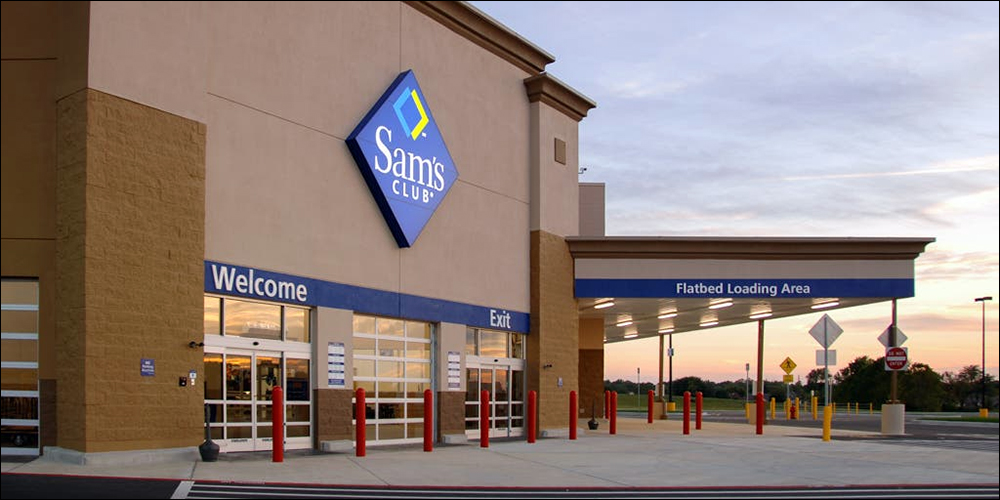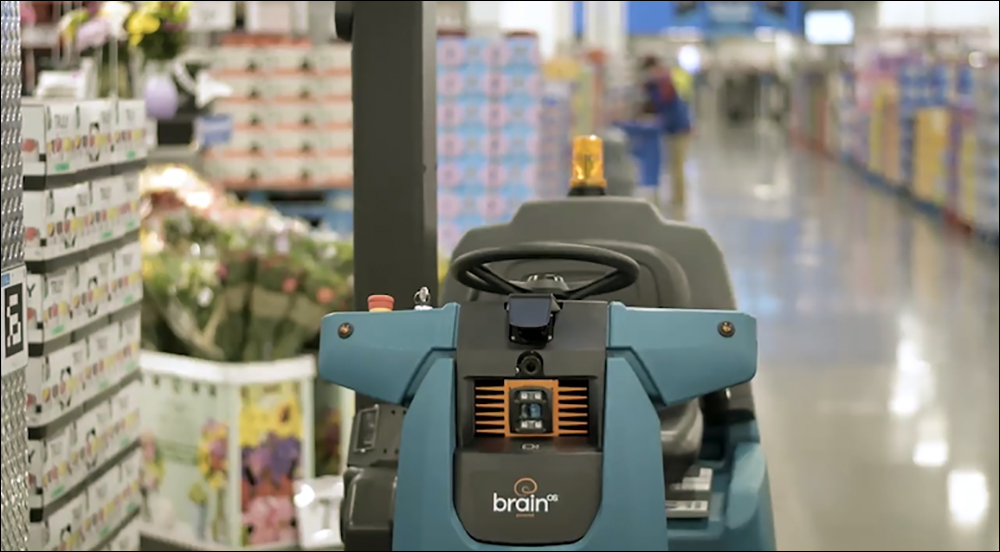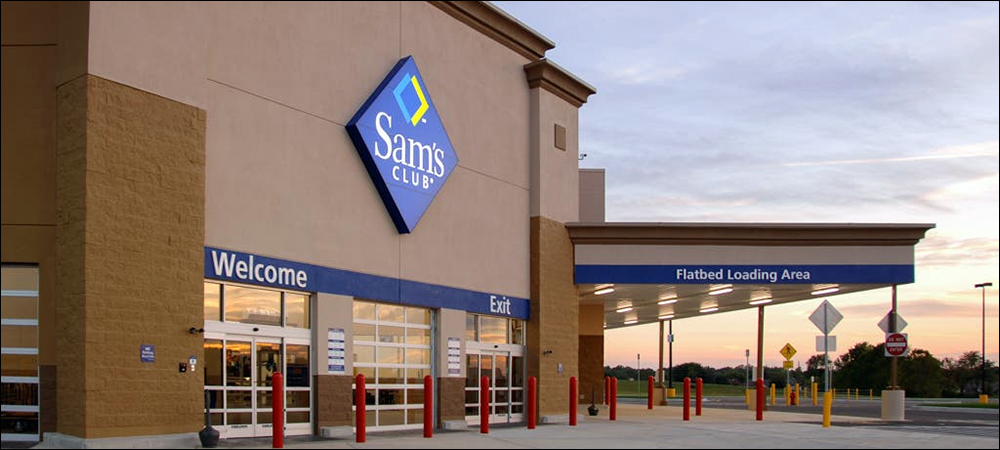- Freeing Up Staff Members’ Time
- Conducting Automated Inventory Counts Each Night
- Providing Employees with Analytics via an App
National big-box retailer Sam’s Club is automating the management of on-shelf merchandise by identifying item, location and price label accuracy, with the help of a floor-cleaning robot equipped with computer vision technology. The solution leverages the store’s previous investment in robotic cleaning machines that autonomously drive through aisles, scrubbing floors while navigating and avoiding obstacles. With the addition of computer vision, the stores now have a view into on-shelf merchandise availability, as well as where products need to be replenished, removed or adjusted, according to analysis of the computer vision images.
Sam’s Club is a membership-only retail warehouse club that is owned and operated by Walmart. Its 600 warehouse clubs are located throughout 44 states, as well as in Puerto Rico and the U.S. Virgin Islands. The stores, known as “clubs,” sell merchandise in bulk. Typically, excess product is stored on the top shelves, rather than in a storage room, while the floor houses sellable goods, often sold on pallets. When goods are sold from the floor, they can then be replenished from the top shelf.
The company’s goal is to empower workers with tools and insights to unlock more time to assist Sam’s Club members, which it claims is a key differentiator from other retailers. So in late 2018, Sam’s Club investigated autonomous floor scrubbers that can be driven manually, while also offering the capability for self-guidance. “We thought the concept of autonomous scrubbers would be a tool that would enable associates to redirect time toward members,” says Todd Garner, Sam’s Club’s VP of in-club product management, “so we began a limited test.”

Sam’s Club is automating the management of on-shelf merchandise by identifying item, location and price label accuracy, with the help of a floor-cleaning robot equipped with computer vision technology.
Freeing Up Staff Members’ Time
Once the Tennant floor scrubber was tested at several sites, Garner recalls, “We realized autonomous scrubbers were adding value to members and associates, and we began a rollout across all clubs.” The company next considered other value the robotic device could provide, and it looked at its store shelf inventory, location and management processes. Traditionally, Sam’s Club sites around the United States employed a manual method of inventory tracking. Staff members used pen and paper to track what was stocked properly on shelves, as well as what needed to be replenished.
This was prone to being a highly time-consuming process, Garner recalls. With the initial paper-based inventory process, the printed reports used by store personnel were filled with a large amount of unprioritized data regarding goods that should be on the shelves. For those workers, inventory management required an exhaustive process of reading long lists of inventory details, then sorting out the priorities. The company’s more recent inventory-management iteration was digitally focused, he explains.
“We developed this suite of tools,” Garner says, “and our focus was basically to provide better insight and make it easier to act on that insight.” The software tools would prioritize information and provide filtering, and they could at times enable corrective action automatically. “But ultimately, it was still dependent on the associate finding an issue, diagnosing that issue and then acting on that issue.” The retailer considered a variety of options to remove the manual labor from the process, including drones and fixed cameras, before settling on the scrubbers, already on hand at each store, for the most consistent, reliable and accurate data.
Sam’s Club decided that computer vision functionality would allow it to understand conditions on shelves, and thus when stocking needed to be accomplished. The solution chosen is the T7AMR Shelf Analytics Accessory, developed by robotics company Brain Corp. and manufactured by Tennant. Tennant built three cameras onto each scrubber robot, along with wireless connectivity to send photos to image-processing software, which automatically identifies and flags areas where action is required. All scrubber systems in the company’s 600 stores now include the camera vision scanning functionality.

The solution chosen is the T7AMR Shelf Analytics Accessory, developed by robotics company Brain Corp. and manufactured by Tennant.
Conducting Automated Inventory Counts Each Night
Typically, the scrubbers are set to work each morning by scanning the beginning inventory. The scrubbers include sensors that detect their location within the store, enabling them to recognize and avoid obstacles, passing around a cart, shelf fixture or other item that stands in their path. While the robots are preprogrammed to follow a fixed route, they use the sensors to avoid obstacles along the way.

Todd Garner
The system includes a tower mounted above the scrubber, on which are located three cameras—two facing one way, plus a third facing in the opposite direction. One camera is mounted at mid-height, while another scans at the lower shelf level. On the other side of the robot, the third camera is pointed up at the highest shelf, where excess merchandise is stored. The vision-based system for shelf scanning begins collecting image-based data about all three shelf levels in all of the aisles.
To scan the shelves, the scrubber moves through every aisle twice, once in each direction. Cameras take pictures that are then linked to the scrubber’s location, and the Brain software processes those photos using computer imaging, then translates that data to insights for club associates. These insights can be used to accomplish multiple tasks, Garner says, adding, “A good shopping experience is really related to making sure the items are correctly priced, making sure that items are out for sale, making sure that items are findable.”
The software can identify proper or improper price marking on shelf labels, with any price discrepancies flagged for employee attention. Additionally, the scrubbers can determine the level of on-shelf inventory for each stock-keeping unit, highlighting products for which re-ordering will soon be necessary. Moreover, the system can detect if a product is in the wrong part of the store or on the wrong shelf.
Providing Employees with Analytics via an App
Staff members have access to insights on their mobile devices, Garner says, using the company’s ecosystem of apps. The initial pilot of the scanning solution began in late 2019 at several Sam’s Clubs in California, after which the company began rolling out the solution chainwide throughout 2021.
With the scanning functionality and the analysis that can result, Garner says, “I truly believe that Sam’s Club is pioneering brick-and-mortar innovation, and so we’re continuing to develop and evolve this as we go.” Other technology is being considered for future applications, he notes, including UHF RFID tags and readers to definitively identify exact quantities of select products, such as apparel. “As we complete one use case, and as we solve one problem, then we move on to the next one and the next one.”
To date, the value provided by the scanning system has been the assurance that products are available on shelves, and that prices are properly marked, without requiring hours of tedious labor on the part of staff members. “We believe that if we can provide our associates with the right insights at the right time, it’s a better experience for the associates and for members,” Garner says. “It’s a better experience for all, and ultimately it’s the real value that that our members expect from us.”
Key Takeaways:
- Sam’s Club is leveraging its existing robotics floor scrubber technology to capture on-shelf inventory data and pricing information, with the computer vision add-on.
- The technology is saving store associates time that would previously be spent manually checking stocking and price labels.


